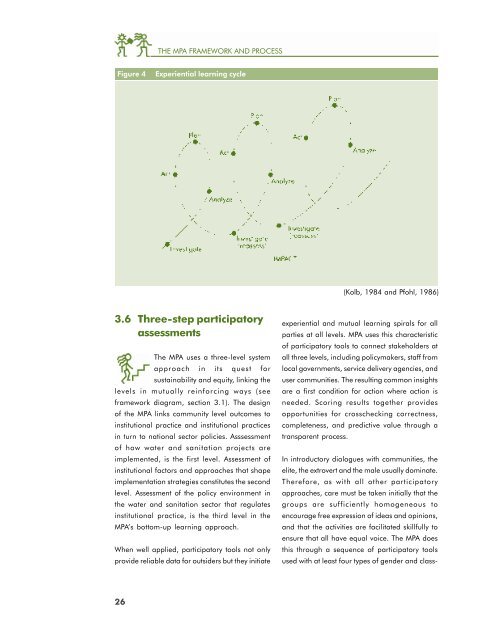Sustainability Planning and Monitoring
Sustainability Planning and Monitoring
Sustainability Planning and Monitoring
- No tags were found...
You also want an ePaper? Increase the reach of your titles
YUMPU automatically turns print PDFs into web optimized ePapers that Google loves.
THE MPA FRAMEWORK AND PROCESSFigure 4Experiential learning cycle(Kolb, 1984 <strong>and</strong> Pfohl, 1986)3.6 Three-step participatoryassessmentsThe MPA uses a three-level systemapproach in its quest forsustainability <strong>and</strong> equity, linking thelevels in mutually reinforcing ways (seeframework diagram, section 3.1). The designof the MPA links community level outcomes toinstitutional practice <strong>and</strong> institutional practicesin turn to national sector policies. Asssessmentof how water <strong>and</strong> sanitation projects areimplemented, is the first level. Assessment ofinstitutional factors <strong>and</strong> approaches that shapeimplementation strategies constitutes the secondlevel. Assessment of the policy environment inthe water <strong>and</strong> sanitation sector that regulatesinstitutional practice, is the third level in theMPA’s bottom-up learning approach.When well applied, participatory tools not onlyprovide reliable data for outsiders but they initiateexperiential <strong>and</strong> mutual learning spirals for allparties at all levels. MPA uses this characteristicof participatory tools to connect stakeholders atall three levels, including policymakers, staff fromlocal governments, service delivery agencies, <strong>and</strong>user communities. The resulting common insightsare a first condition for action where action isneeded. Scoring results together providesopportunities for crosschecking correctness,completeness, <strong>and</strong> predictive value through atransparent process.In introductory dialogues with communities, theelite, the extrovert <strong>and</strong> the male usually dominate.Therefore, as with all other participatoryapproaches, care must be taken initially that thegroups are sufficiently homogeneous toencourage free expression of ideas <strong>and</strong> opinions,<strong>and</strong> that the activities are facilitated skillfully toensure that all have equal voice. The MPA doesthis through a sequence of participatory toolsused with at least four types of gender <strong>and</strong> class-26
















